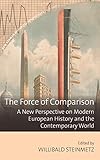The Force of Comparison : A New Perspective on Modern European History and the Contemporary World / Willibald Steinmetz.
Material type: TextSeries: New German Historical Perspectives ; 11Publisher: New York ; Oxford : Berghahn Books, [2019]Copyright date: ©2019Description: 1 online resource (354 p.)Content type:
TextSeries: New German Historical Perspectives ; 11Publisher: New York ; Oxford : Berghahn Books, [2019]Copyright date: ©2019Description: 1 online resource (354 p.)Content type: - 9781789203356
- 9781789203363
- 940.2 23
- D208 .F673 2019
- online - DeGruyter
| Item type | Current library | Call number | URL | Status | Notes | Barcode | |
|---|---|---|---|---|---|---|---|
 eBook
eBook
|
Biblioteca "Angelicum" Pont. Univ. S.Tommaso d'Aquino Nuvola online | online - DeGruyter (Browse shelf(Opens below)) | Online access | Not for loan (Accesso limitato) | Accesso per gli utenti autorizzati / Access for authorized users | (dgr)9781789203363 |
Frontmatter -- Contents -- Figures and Tables -- Introduction: Concepts and Practices of Comparison in Modern History -- 1 Outlines of a Historical Epistemology of Comparison: From Descartes to the Early Nineteenth Century -- 2 Comparative Practices and Their Implications: The Case of Comparative Viewing -- 3 Above/Below, Better/Worse or Simply Different? Metamorphoses of Social Comparison, 1600–1900 -- 4 Empowering Comparisons? The Making of Republics in the Early Modern Period -- 5 Comparing Europe and the Americas: The Dispute of the New World between the Sixteenth and Nineteenth Centuries -- 6 European Colonial Empires and Victorian Imperial Exceptionalism -- 7 Comparison and the Welfare State in Modern Europe, c. 1880–1945 -- 8 Comparison, Rivalry and Competition under Neoliberalism and State Socialism -- 9 Comparing Economic Activities on a Global Level in the 1920s and 1930s Motives and Consequences -- 10 In Search of a Global Centre of Calculation: The Washington Statistical Conferences of 1947 -- 11 Formalized Comparisons: Rankings and Status in Higher Education -- 12 Good – Better – Best: Comparisons and the Power of Ranking Orders -- Index
restricted access online access with authorization star
http://purl.org/coar/access_right/c_16ec
In an era defined by daily polls, institutional rankings, and other forms of social quantification, it can be easy to forget that comparison has a long historical lineage. Presenting a range of multidisciplinary perspectives, this volume investigates the concepts and practices of comparison from the early modern period to the present. Each chapter demonstrates how comparison has helped to drive the seemingly irresistible dynamism of the modern world, exploring how comparatively minded assessors determine their units of analysis, the criteria they select or ignore, and just who it is that makes use of these comparisons—and to what ends.
Mode of access: Internet via World Wide Web.
In English.
Description based on online resource; title from PDF title page (publisher's Web site, viewed 25. Jun 2024)


